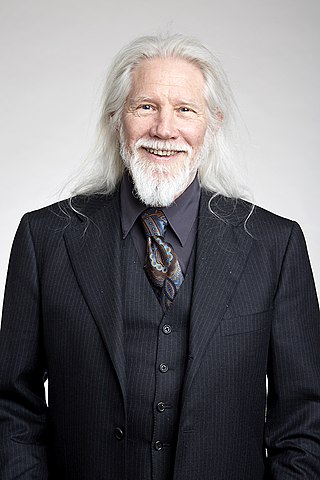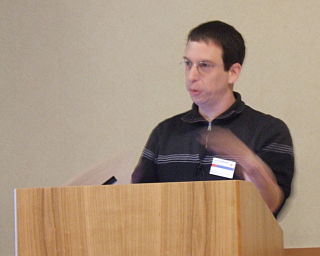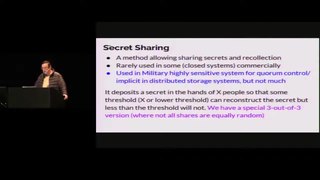Related Research Articles

The Advanced Encryption Standard (AES), also known by its original name Rijndael, is a specification for the encryption of electronic data established by the U.S. National Institute of Standards and Technology (NIST) in 2001.
In cryptography, key size or key length refers to the number of bits in a key used by a cryptographic algorithm.

In cryptography, encryption is the process of encoding information. This process converts the original representation of the information, known as plaintext, into an alternative form known as ciphertext. Ideally, only authorized parties can decipher a ciphertext back to plaintext and access the original information. Encryption does not itself prevent interference but denies the intelligible content to a would-be interceptor.
A cypherpunk is any individual advocating widespread use of strong cryptography and privacy-enhancing technologies as a route to social and political change. Originally communicating through the Cypherpunks electronic mailing list, informal groups aimed to achieve privacy and security through proactive use of cryptography. Cypherpunks have been engaged in an active movement since at least the late 1980s.
In computing, Internet Protocol Security (IPsec) is a secure network protocol suite that authenticates and encrypts packets of data to provide secure encrypted communication between two computers over an Internet Protocol network. It is used in virtual private networks (VPNs).

Symmetric-key algorithms are algorithms for cryptography that use the same cryptographic keys for both the encryption of plaintext and the decryption of ciphertext. The keys may be identical, or there may be a simple transformation to go between the two keys. The keys, in practice, represent a shared secret between two or more parties that can be used to maintain a private information link. The requirement that both parties have access to the secret key is one of the main drawbacks of symmetric-key encryption, in comparison to public-key encryption. However, symmetric-key encryption algorithms are usually better for bulk encryption. With exception of the one-time pad they have a smaller key size, which means less storage space and faster transmission. Due to this, asymmetric-key encryption is often used to exchange the secret key for symmetric-key encryption.

Bailey Whitfield 'Whit' Diffie, ForMemRS, is an American cryptographer and mathematician and one of the pioneers of public-key cryptography along with Martin Hellman and Ralph Merkle. Diffie and Hellman's 1976 paper New Directions in Cryptography introduced a radically new method of distributing cryptographic keys, that helped solve key distribution—a fundamental problem in cryptography. Their technique became known as Diffie–Hellman key exchange. The article stimulated the almost immediate public development of a new class of encryption algorithms, the asymmetric key algorithms.
Key management refers to management of cryptographic keys in a cryptosystem. This includes dealing with the generation, exchange, storage, use, crypto-shredding (destruction) and replacement of keys. It includes cryptographic protocol design, key servers, user procedures, and other relevant protocols.

The export of cryptography from the United States to other countries has experienced various levels of restrictions over time. World War II illustrated that code-breaking and cryptography can play an integral part in national security and the ability to prosecute war. Changes in technology and the preservation of free speech have been competing factors in the regulation and constraint of cryptographic technologies for export.
End-to-end encryption (E2EE) is a private communication system in which only communicating users can participate. As such, no one, including the communication system provider, telecom providers, Internet providers or malicious actors, can access the cryptographic keys needed to converse.
Bart Preneel is a Belgian cryptographer and cryptanalyst. He is a professor at Katholieke Universiteit Leuven, in the COSIC group.
Strong cryptography or cryptographically strong are general terms used to designate the cryptographic algorithms that, when used correctly, provide a very high level of protection against any eavesdropper, including the government agencies. There is no precise definition of the boundary line between the strong cryptography and (breakable) weak cryptography, as this border constantly shifts due to improvements in hardware and cryptanalysis techniques. These improvements eventually place the capabilities once available only to the NSA within the reach of a skilled individual, so in practice there are only two levels of cryptographic security, "cryptography that will stop your kid sister from reading your files, and cryptography that will stop major governments from reading your files".
Authenticated Encryption (AE) is an encryption scheme which simultaneously assures the data confidentiality and authenticity. Examples of encryption modes that provide AE are GCM, CCM.

Dan Boneh is an Israeli–American professor in applied cryptography and computer security at Stanford University.

Cryptography, or cryptology, is the practice and study of techniques for secure communication in the presence of adversarial behavior. More generally, cryptography is about constructing and analyzing protocols that prevent third parties or the public from reading private messages. Modern cryptography exists at the intersection of the disciplines of mathematics, computer science, information security, electrical engineering, digital signal processing, physics, and others. Core concepts related to information security are also central to cryptography. Practical applications of cryptography include electronic commerce, chip-based payment cards, digital currencies, computer passwords, and military communications.

Lightweight Portable Security (LPS) or Trusted End Node Security (TENS) was a Linux LiveCD (or LiveUSB) distribution. The application Encryption Wizard, originally bundled with TENS is still actively maintained. LPS and its successor TENS was developed and publicly distributed by the United States Department of Defense’s Air Force Research Laboratory The live CD is designed to serve as a secure end node. The Air Force Research Laboratory actively maintained LPS and TENS from 2007 to 2021. It can run on almost any x86_64 computer (PC or Mac). LPS boots only in RAM, creating a pristine, non-persistent end node. It supports DoD-approved Common Access Card (CAC) readers, as required for authenticating users into PKI-authenticated gateways to access internal DoD networks.

Mordechai M. "Moti" Yung is a cryptographer and computer scientist known for his work on cryptovirology and kleptography.

Hardware-based encryption is the use of computer hardware to assist software, or sometimes replace software, in the process of data encryption. Typically, this is implemented as part of the processor's instruction set. For example, the AES encryption algorithm can be implemented using the AES instruction set on the ubiquitous x86 architecture. Such instructions also exist on the ARM architecture. However, more unusual systems exist where the cryptography module is separate from the central processor, instead being implemented as a coprocessor, in particular a secure cryptoprocessor or cryptographic accelerator, of which an example is the IBM 4758, or its successor, the IBM 4764. Hardware implementations can be faster and less prone to exploitation than traditional software implementations, and furthermore can be protected against tampering.
This is a list of cybersecurity information technology. Cybersecurity is security as it is applied to information technology. This includes all technology that stores, manipulates, or moves data, such as computers, data networks, and all devices connected to or included in networks, such as routers and switches. All information technology devices and facilities need to be secured against intrusion, unauthorized use, and vandalism. Additionally, the users of information technology should be protected from theft of assets, extortion, identity theft, loss of privacy and confidentiality of personal information, malicious mischief, damage to equipment, business process compromise, and the general activity of cybercriminals. The public should be protected against acts of cyberterrorism, such as the compromise or loss of the electric power grid.
Ingrid Verbauwhede is a professor at the COSIC Research Group of the Electrical Engineering Department, KU Leuven, where she leads the embedded systems team. She is a pioneer in the field of secure embedded circuits and systems, with several awards recognising her contributions to the field. She is member of the Royal Flemish Academy of Belgium for Science and the Arts since 2011. She is a fellow of IEEE.
References
- 1 2 3 "About us - COSIC". www.esat.kuleuven.be. 2023-02-01. Retrieved 2023-08-21.
- ↑ "Computer Security and Industrial Cryptography - COSIC". www.esat.kuleuven.be (in Dutch). Retrieved 2017-08-30.
- ↑ "COSIC Research - COSIC". www.esat.kuleuven.be (in Dutch). Retrieved 2017-08-30.